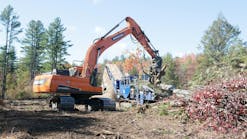Excavation, by definition, goes below the surface. What concerns us here is the work that may follow the excavation, work that is performed underground, where there may be no daylight, no direct connection with what is visible to everybody on the ground. Much of our infrastructure is underground. Foundations? Pipes? Telecommunications? As the need for repairs and reconstruction grows, so does the need for contractors who can do that underground work efficiently and, above all, safely. Some of the work underground will be demolition, deconstruction rather than construction, so that new and better structures can be built.
The type of specialized equipment used for underground work may play a bigger role than in normal construction. Sometimes there is less room to maneuver underground, even in some projects that look huge from some angles. Backhoes and skid-steers show their value in underground work, compact machines with powerful attachments that are the princes of production. The Port of Miami, FL, is used to 16,000 vehicles traveling through every day, and there’s little space above ground to expand bridges and roads. So, let’s go down! The construction of twin tunnels will make the traffic problems much easier to handle. The machine that makes your jaw drop in amazement is the massive, German-built, tunnel-boring machine. Its cutterhead is four stories high, and the body is longer than a football field. It cuts a path underground (advancing between 23 and 43 feet per day) to make room for the placing of precast concrete segments. This concrete forms the rings of a 42-foot diameter tube (to be completed this year) that will contain two traffic lanes, curbs, and walkways connecting Watson Island and the Port of Miami, under Government Cut, the main shipping channel in Biscayne Bay. When the boring machine reaches the southern side of the cut, it will be repositioned to cut a similar tunnel back to the mainland. Then there will be four traffic lanes, two in each direction.




